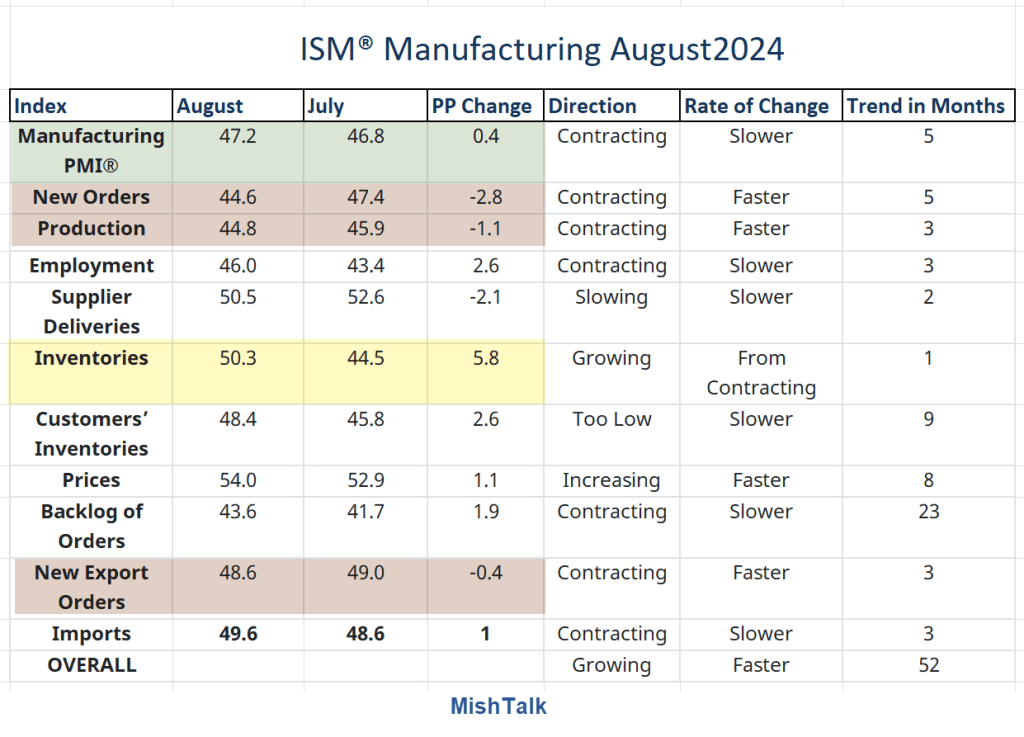The manufacturing ISM is a bet improved, but three key components are worse.

Please consider the August 2024 Manufacturing ISM® Report On Business® emphasis mine.
The U.S. manufacturing sector contracted for the fifth consecutive month in August, as the Manufacturing PMI® registered 47.2 percent, up 0.4 percentage point compared to July’s reading of 46.8 percent. “After breaking a 16-month streak of contraction by expanding in March, the manufacturing sector has contracted the last five months, but at a slower rate in August. Of the five subindexes that directly factor into the Manufacturing PMI®, only one (Supplier Deliveries) was in expansion territory, the same as in July. The New Orders Index remained in contraction and moved downward in August. Two of the six biggest manufacturing industries (Food, Beverage & Tobacco Products; and Computer & Electronic Products) registered growth,” says Timothy R. Fiore Chair of the Institute for Supply Management® (ISM®) Manufacturing Business Survey Committee. A reading above 50 percent indicates that the manufacturing sector is generally expanding; below 50 percent indicates that it is generally contracting.
A Manufacturing PMI® above 42.5 percent, over a period of time, generally indicates an expansion of the overall economy. Therefore, the August Manufacturing PMI® indicates the overall economy grew for the 52nd straight month after last contracting in April 2020. “The past relationship between the Manufacturing PMI® and the overall economy indicates that the August reading (47.2 percent) corresponds to a change of plus-1.3 percent in real gross domestic product (GDP) on an annualized basis,” says Fiore.
Production
The Production Index continued in contraction territory in August, registering 44.8 percent, 1.1 percentage points lower than the July reading of 45.9 percent. Of the six largest manufacturing sectors, only Computer & Electronic Products reported increased production. The index is at its lowest level since May 2020, when it registered 34.2 percent. “Panelists’ companies reduced output levels compared to July. New order rates remain weak, and backlog levels continue to decline. Companies continue to avoid investing in inventory due to the current economic uncertainty,” says Fiore. An index above 52.2 percent, over time, is generally consistent with an increase in the Federal Reserve Board’s Industrial Production figures.
New Orders
ISM®’s New Orders Index contracted in August for the fifth consecutive month, registering 44.6 percent, a decrease of 2.8 percentage points compared to July’s figure of 47.4 percent. The New Orders Index hasn’t indicated consistent growth since a 24-month streak of expansion ended in May 2022. “
Employment
ISM®’s Employment Index registered 46 percent in August, 2.6 percentage points higher than the July reading of 43.4 percent. The July and August readings are among the four lowest recorded since the index registered 43.7 percent in July 2020, early in the economic recovery; the others are 45.9 percent in February and 45 percent in July 2023. “The index contracted for the third consecutive month after an expansion in May, which broke a seven-month streak of contraction. Of the six big manufacturing sectors only Food, Beverage & Tobacco Products expanded employment in August, primarily due to seasonality factors. Respondents’ companies are continuing to reduce head counts through layoffs, attrition and hiring freezes. Sentiment in August indicated continued staff reductions compared to July, supported by the approximately 1-to-1.2 ratio of hiring versus head-count reduction comments,” says Fiore. An Employment Index above 50.3 percent, over time, is generally consistent with an increase in the Bureau of Labor Statistics (BLS) data on manufacturing employment.
Inventories
The Inventories Index registered 50.3 percent in August, up a substantial 5.8 percentage points compared to the reading of 44.5 percent reported in July. “Manufacturing inventories grew as a result of panelists’ companies adjusting to lower new output levels and the subsequent timing issues.”
Inventories are increasing because production is down.
New Export Orders
ISM®’s New Export Orders Index registered 48.6 percent in August, down 0.4 percentage point from July’s reading of 49 percent. “The New Export Orders Index reading indicates that export orders contracted for a third month after expanding in May and contracting in April, with two straight months of expansion before that. New export orders remain sluggish as international trading partners continue to struggle with weak economies,” says Fiore.
This was not a good report despite improvements in inventories and less contraction in in employment.
With new orders, new export orders, and production worsening, employment is headed nowhere.
There is little to cheer about in any economic reports. And a big international trade war is on the horizon.
For discussion, please see Faced with Stagnant Domestic Growth China Starts a New Global Trade War